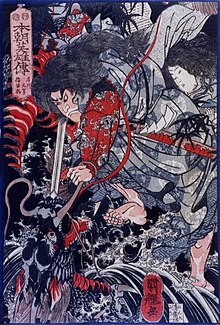Yamata no Orochi
![]()
This article is about the giant snake Orochi. For the roller coaster of the same name, see Monster (Walygator Parc).
Yamata no Orochi (Japanese ヤマタノオロチ; Kojiki: 八岐遠呂智; Nihonshoki: 八岐大蛇) is a dragon from Shintō mythology. Its name, according to Karl Florenz's translation, means "eight-forked giant serpent".
After his banishment from the heavenly realms (Takamanohara) Susanoo descended to Tori-kami and after some time met an old, weeping couple with a child between them at the river Hi. The old man introduced himself as the son of Ōyamatsumi, Ashinazuchi by name. His wife would be called Tenazuchi and the child Kushinadahime (in alternative versions of the Nihonshoki, Kushinadahime is not yet born at this time).
When asked about the reason for her grief, Tenazuchi told Susanoo that he had originally had eight daughters. But the eight-forked giant snake had come every year and eaten one of them. Now that the time had come for the snake to come again, they would cry. When Susanoo asked about the figure, Ashinazuchi answered him, "Her eyes are [red like] bladder cherries, and on her one body she has eight heads and eight tails. Besides, on her body grow moss [(koke)] and also cypress [(hinoki)] and cryptomeria. Her length reaches over eight valleys and eight hills, and if you look at her belly, it is constantly bloody (and) inflamed everywhere."
Upon Ashinazuchi's promise to give him his daughter, Susanoo devises a ruse that he has the old couple prepare: He orders them to brew eightfold sake, build a fence with eight gates, and tie eight raised racks together at each of the gates. A vessel containing the eightfold brewed sake is then to be placed on each rack.
After Ashinazuchi and Tenazuchi had done so, the eight-forked giant snake came, drank with its heads from all the vessels, and immediately fell drunk into a deep sleep (in an alternative Nihonshoki version, Susanoo herself instills the sake into the snake). Thereupon Susanoo slew the dragon with his ten handbreadth sword (a tsurugi), thereby staining the hi red with blood. While slashing the middle tail, Susanoo chipped his sword and found the 'grass maiden' sword (kusanagi-no-tachi, later one of the three insignia of the throne of Japan) on it.
The battle of Susanoo against Yamatanoorochi is an oft-discussed theme in Japanese mythology and serves as an occasion for celebration in many Shintō shrines. Among the many interpretations, one says that the child's name Kushi(i)nadahime is an allusion to rice paddies and that the serpent is the river Hi itself, so its conquest by Susanoo should be understood as harnessing wild nature for agricultural purposes. Another view, held by Jean Herbert, is based on Yamatanoorochi as the personification of earthly forces, which Ashinazuchi and Tenazuchi, two celestial kami, cannot resist because they themselves use only earthly forces. (This is based on their names, which mean "foot-stroking old man" and "hand-stroking old woman," but in Florence's case are a reference to her physical tenderness toward her child). Also significant in an esoteric sense is the strikingly frequent occurrence of the number eight, which also reappears after this episode in the construction of Susanoo's palace (a full 50 times in the Kojiki). The exact meaning of this number is disputed, however, and is usually translated as "a lot." Eight could, for example, be a symbol of perfection, infinity or holiness, or it could also refer to the cardinal points of the eight trigrams.

Susanoo slays the Yamata no Orochi (ca. 1870, Chikanobu Toyohara)

Susanoo fights the eight-headed dragon Yamata no Orochi in a Japanese myth (picture by Utagawa Kuniteru)
Search within the encyclopedia